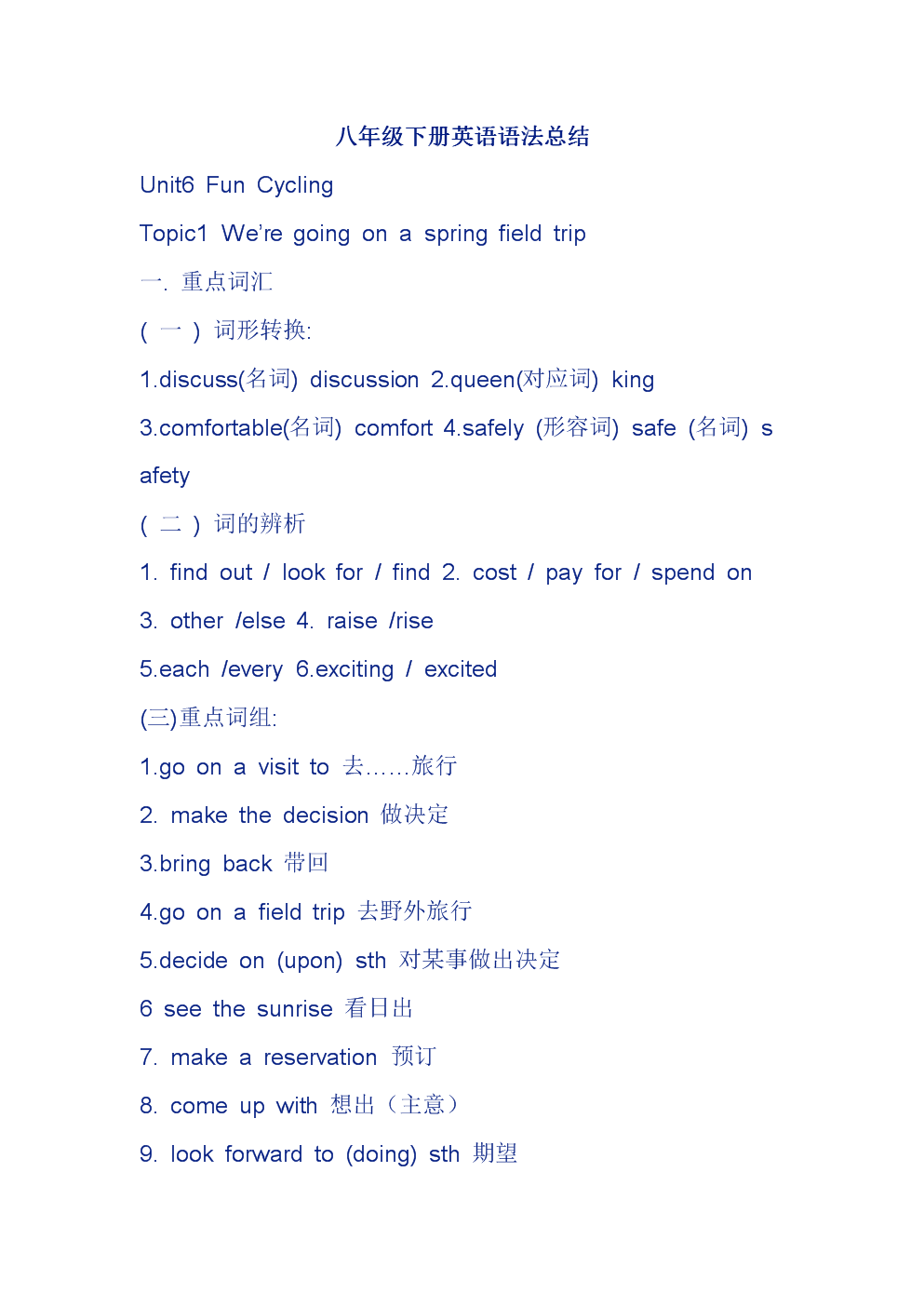
语法要点
表示说话人的情绪、态度或语气的动词叫情态动词。情态动词本身有一定的词义,但它也和助动词一样,不能单独作谓语,情态动词后必须跟动词原形。
情态动词的语法特征:
1. 不能表示正在发生或已经发生的事情,只表示期待或估计某事的发生;
2. 没有人称和数的变化;也没有不定式、分词等形式;
3. 除ought和have 以外,后面只能接动词原形;
4. need 和dare等既可以作情态动词,也可以作行为动词,要注意它们的具体用法。
一、情态动词的种类及基本用法
情态
动词
词义 过去式或
语气委婉
否定形式 一般疑问句 意思相同的
相关词组
can 能 could cannot / can’t;couldn’t can/could提前 be able to
may 或许 might may not / mayn’t;
might not / mightn’t
may/might 提前
must 必须
不得不
must,
had to
must not / mustn’t 1. must提前

2. have/has to 要根据时态和人称用相应的助动词提前
have / has to do
will 意愿 would will not/ won’t;wouldn’t will/ would提前
shall 应该 should shall not / shan’t;
should not / shouldn’t
shall / should提前 ought to do
had
better
最好 had better had better not do had better do
need 需要 needed need not / needn’t need提前
dare 敢 dared dare not / daren’t dare提前
二、常用情态动词用法比较
1. can,could 和 be able to的用法比较
情态动词 语法范围 用法 举例
can 用于一般现在时 1. 表示能力;
2. 表示可能性;
3. 表示允许(跟may意思相近);
4. 表示怀疑、猜测和 惊异(主要用于否定句和否定回答中)。
1. She can swim now. 她现在会游泳。
2. She can’t be Millie. She has gone to England. 她不可能是米莉,她已到英国去了。
3. Can I borrow your bicycle?我可以借你的自行车吗?
4. How can that be ture? 那怎么可能是真的?
could 用于一般过去时 1. 表示能力;
2. 表示可能性(可能性比can小,此时不表示时态);
3. 表示语气委婉;
4. 表示怀疑、不相信。
1. Simon couldn’t swim when he was 8. 西蒙八岁时还不会游泳。
2. Could he keep secrets for us? 他能为我们保守秘密吗?
3. Could I speak to Andy, please? 请找安迪接电话,好吗?
4. How could he be so selfish? 他怎么会这么自私?
be able to 可用于各种时态 1. 用于助动词和情态动词后;
2. 强调经过努力,终于能做某事了,有强烈的感情色彩。
1. He will be able to be a singer. 他终将成为歌手。
2. After ten years of hard work,he was able to enjoy his success. 经过十年努力,他终于能够享受成功了。
2. may 和might的用法比较
情态动词 用法 举例
may 1. 表示允许或请求;
2. 放在句首,表示祝愿;
3. 表示可能性。
1. May I come in? 我可以进来吗?
2. May you Merry Christmas! 祝圣诞节快乐!
3. Simon may play football today. 西蒙今天可能会去踢足球。
续表
情态动词 用法 举例
might 1. may的过去式;
2. 表示可能性,可能性比may更小,此时不表示时态;
3. 表示语气委婉、客气。

1. She said that she might come here. 她说她会来的。
2. Millie might catch a fish within 5 minutes. 米莉可以在5分钟之内抓到一条鱼。
3. Might I use your mobile phone?我可以用你的手机吗?
特别提示:
can,could,may和might 都可以表示可能性,但程度不一样。它们所表示的可能性大小排列为:can>could>may>might。
3. must和have to的用法比较
情态动词 时态范围 用法 举例
must 没有人称、时态和数的变化 1. 表示说话人主观看法和主观必要;
2. 否定结构是mustn’t,表示禁止;
3. 对must的一般疑问句的否定回答要用needn’t;
4. 表示很有把握的推断。
1. You must buy a ticket to go into the cinema. 你必须买票去看电影。
2. You mustn’t spit in public. 禁止在公共场合随地吐痰。
3. —Must I finish my homework today? 今天我一定要完成我的家庭作业吗?
—Yes, you must. /No. you needn’t. 是的,你一定要。/不,你不必。
4. That book must be Sandy’s. Her name is on it. 那本书一定是萨迪的,她的名字还在上面呢。
have to 用于各种时态 1. 表示客观需要;
2. 否定结构要根据人称和时态,用不同的助动词加not构成(如doesn’t have to)表不必。
1. You have to tell your parents before you go out. 在你出门之前你必须跟你父母说一下。
2. You don’t have to tell him about it. 你不一定要把此事告诉他。
4. shall和will 的用法比较
情态动词 过去式 用法 举例
shall should 1. 征求对方意见和指示(用于第一人称);
2. 表示允诺、决心等意愿(用于第二、三人称)。
1. Shall we go out for a walk?我们出去走走,好吗?
2. You shall have your presents soon. 你会很快拿到你的礼物的。
续表
情态动词 过去式 用法 举例
will would 1. 征求对方意见和指示(用于第二、三人称);
2. 表示允诺,决心等意愿(用于第一人称)。
1. Will you play games with us?和我们一起玩游戏,好吗?
2. I will go there no matter what happens. 不管发生什么事,我都会去那儿的。
5. need 的用法
词性 用法 举例
情态动词 1. 表示必须,主要用于否定句和一般疑问句中;
2. 回答由need提出的一般疑问句时,肯定用must;否定用needn’t。
1. You needn’t worry about him. 你不必为他担心。
2. —Need I finish my homework today? 我必须今天完成家庭作业吗?
—Yes, you must. / No, you needn’t. 是的。/ 不,没必要。
行为动词 1. need to do;
2. 否定形式要根据时态和人称用相应的助动词。
1. You don’t need to tell me the truth. 你不必告诉我事实。
2. They said that they needed to go there on time. 他们说他们必须准时到那儿。
6. dare 的用法
词性 用法 举例
情态动词 1. 表示“敢于”,主要用于疑问句、否定句及条件从句;
2. 肯定形式:dare do;
否定形式:dare not / daren’t do。
1. —Dare you catch the mouse? 你敢去抓那只老鼠吗?
—No, I daren’t do that. 不,我不敢抓。
2. If you dare tell that to our teacher, I won’t play with you. 如果你敢把这事告诉老师,我就不和你玩。
行为动词 1. dare to do (在否定句、疑问句中to可省去);
2. 否定形式要根据时态和人称用相应的助动词。
1. Sandy doesn’t dare to tell her mother the truth. 萨迪不敢告诉她妈妈事情的真相。
2. Does he dare (to) step on the snake?他敢踩在蛇身上吗?
更多英语学习知识请关注英语培训班
标签: #初二英语语法基础知识大全








